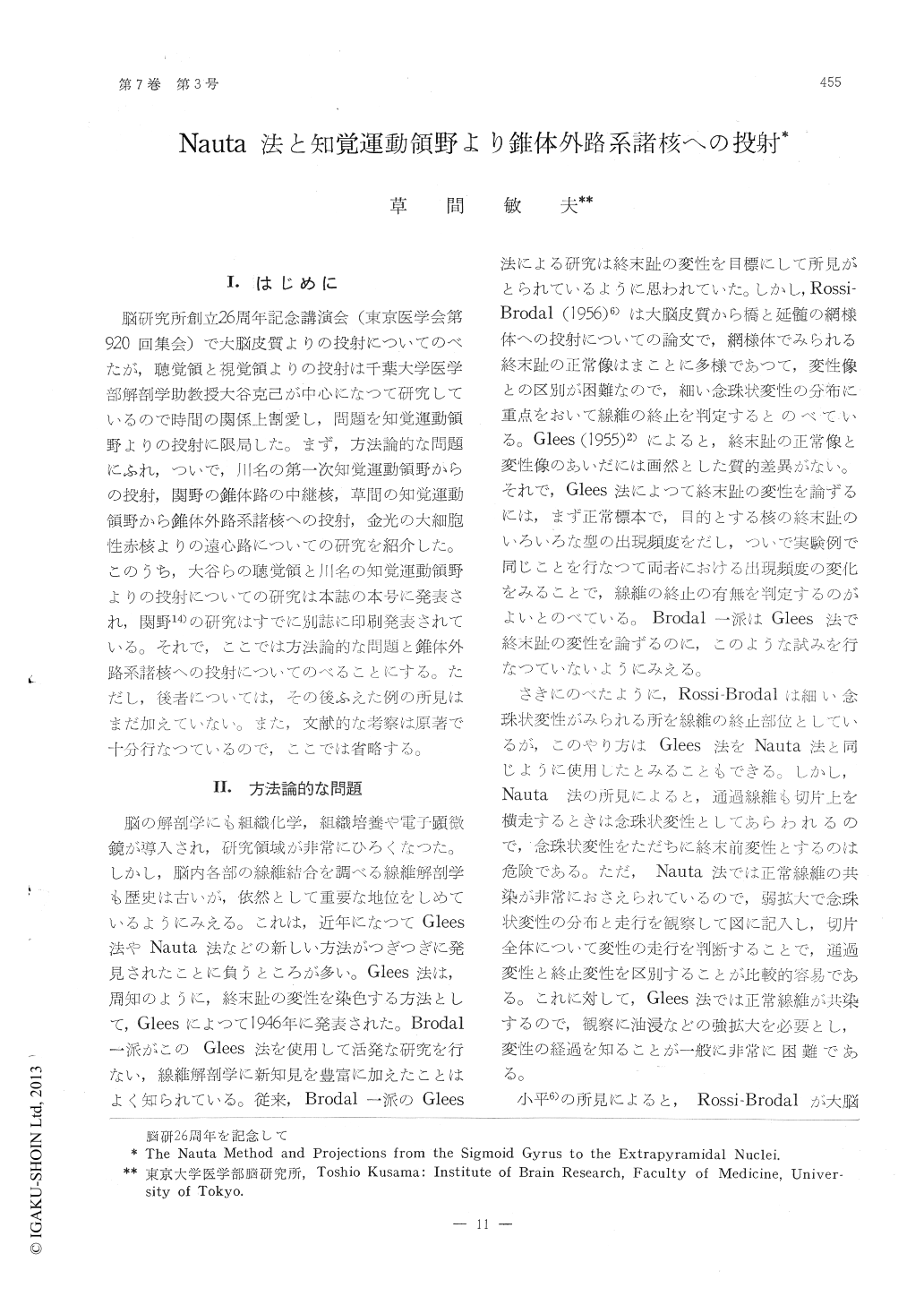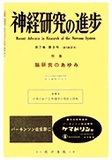Japanese
English
- 有料閲覧
- Abstract 文献概要
- 1ページ目 Look Inside
I.はじめに
脳研究所創立26周年記念講演会(東京医学会第920回集会)で大脳皮質よりの投射についてのべたが,聴覚領と視覚領よりの投射は千葉大学医学部解剖学助教授大谷克己が中心になつて研究しているので時間の関係上割愛し,問題を知覚運動領野よりの投射に限局した。まず,方法論的な問題にふれ,ついで,川名の第一次知覚運動領野からの投射,関野の錐体路の中継核,草間の知覚運動領野から錐体外路系諸核への投射,金光の大細胞性赤核よりの遠心路についての研究を紹介した。このうち,大谷らの聴覚領と川名の知覚運動領野よりの投射についての研究は本誌の本号に発表され,関野14)の研究はすでに別誌に印刷発表されている。それで,ここでは方法論的な問題と錐体外路系諸核への投射についてのべることにする。ただし,後者については,その後ふえた例の所見はまだ加えていない。また,文献的な考察は原著で十分行なつているので,ここでは省略する。
Some critiques on the Nauta method,with special reference to the comparison with the Marchi,the Glees and the evoked potential map method,and our findings on projections from the sigmoid gyrus to the so-called extra-pyramidal nuclei were described.The main points are as follws.
1. As far as our experiences concerned,the original method by Nauta and Gygax were emp-loyed with considerably greater consistency than its modified one described by Nauta in 1957.
2.The map of the evoked potentials recor-ded in the medulla oblongata following single electrical shock of the cerebral somatic areas was compared with the projection patterns from the same cortical areas demonstrated with the Nauta method.As shown in fig.2,distribution of the initial latencies of the resp-onses were nearly the same in the contralateral reticular formation and in the territories of both the contralateral spinal trigeminal and posterior funicular nuclei,in which many dege-nerating axons could be found,while the initial latencies of the ipsilateral responses lengthened on the following order:(A) at the medial part of the reticular formation,in which de-genrating axons were observed,(B) the lateral part of the RF and (C) the territories of both nuclear regions,in which a few or only few degenerating fibers were recognized.
3.Projection from the sigmoid and coronary gyri to the globus pallidus,entopeduncular nu-cleus and substantia nigra could not be indica-ted with the Nauta method.
4.Projections from the sigmoid and coron-ary gyri to the ipsilateral subthalamic nucleus,Forel's field and Darkschewitsch's nucleus and the contralateral inferior olive were very small in number or not definltely indicated.
5.Projection from the sigmoid gyrus to the ipsilateral corpus striatum,magnocellular red nucleus,pontine nuclei and tegmental reticular nucleus and in the contralateral lateral reticu-lar nucleus were so many in number that pro-jections from 4 parts of the sigmoid gyrus (the medial and lateral parts of the anterior and posterior sigmoid gyri) could be compared.
6.As far as our findings concerned,the lateral part of the sigmoid gyrus projected much more numerous fibers to the corpus stri-atum than its medial part.Their terminal por-tion was the dorsolateral part of the caudate nucleus and the dorsal part of the putamen at the level rostral to the decussation of the ant-erior commissure.
7.The medial part of the anterior sigmoid gyrus projected less number of fibers to the pontine nuclei than the other parts.
8.Projection fibers of the medial part of the sigmoid gyrus to the tegmental reticular nucleus were considerably less in number than those from its lateral part.Their terminal por-tion was the nuclear area dorsal to the medial lemniscus.
9.4parts of the sigmoid gyrus projected to the same area in the magnocellular lateral reticular nucleus.The projection from the lateral part of the gyrus were much greater than that from its medial part.
10.While somatotopic localization was not indicated in the projections of the sigmoid gyrus to the above-metioned 4 nuclei of the extrapy-ramidal system,it was definitely demonstrated in projections to the magnocellular red nucle-us:the medial part of the posterior sigmoid gyrus (Kawana's leg area) sent fibers mainly to the ventromedial part of this nucleus;the lateral parts of the anterior and posterior sig-moid gyri (Kawana's arm area) mostly to the dorsolateral part.The somatotopic localization thus obtained agreed with that demonstrated by Brodal et al.with the modified Gudden me-thod in cats with lesions of the rubrospinal tract.
11.These findings will show that the sigmo-id gyrus projects with somatotopic localization through the magnocellular red nucleus to the lower centers.
12.Most of the efferent fibers of the mag-nocellular red nucleus terminated in the same areas as the fibers characteristic of the cortical motor area, but a number of the former en-tered the dorsolateral part of the facial nucle-us and the motor nuclei of the ventral horn,in which the later,however,did not terminate.
13. The medial part of the anterior sigmoid gyrus,which was sometimes referred to as area 6 or the premotor area,sent fibers in much less number to the corpus striatum,the mag-nocellular red nucleus and the lateral reticular nucleus,in considerably less number to the tegmental reticular nucleus and in slightly less number to the pontine nuclei than the other parts of the sigmoid gyrus.

Copyright © 1963, Igaku-Shoin Ltd. All rights reserved.


